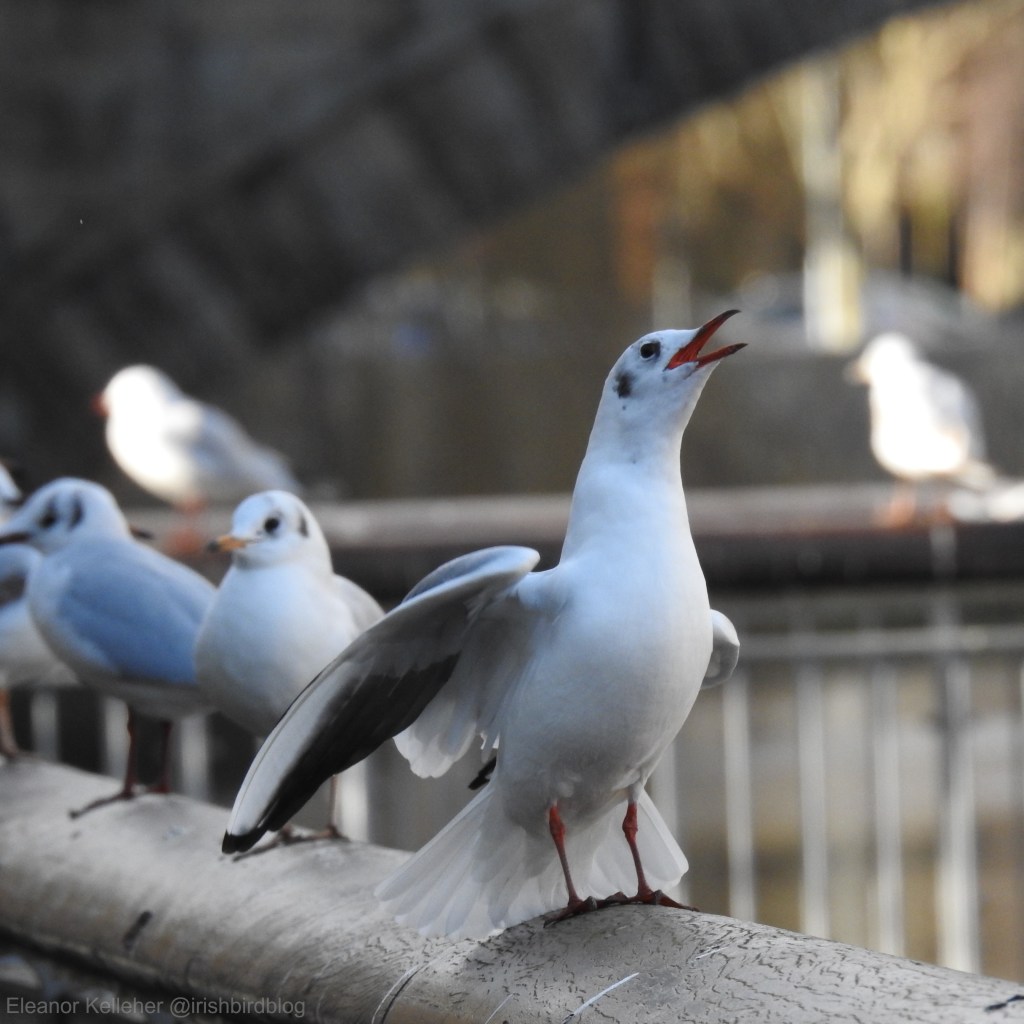Summer is firmly on its way out, so you know what that means! Time for that awkward transition period where a short-sleeved shirt won’t keep you warm enough, but wearing a sweater or jacket will have you sweating by 2 p.m. This month’s bird can commiserate with these woes, since they’re going through something of a style shift themselves. This month’s bird is the black-headed gull (Chroicocephalus ridibundus), known in Irish as Sléibhín.
Black-headed gulls are a type of hooded gull. This classification isn’t necessarily rooted in a scientific definition or anything, it’s just a human categorisation for gulls that have partial or total dark plumage around their heads (and there’s more gulls in this category than I originally would have thought).


In the summer, both the male and female birds sport a head full of dark feathers. This is done to attract mates, with darker, more clearly-defined hoods being seen as more attractive. Their hood is actually a very dark brown, but from a distance it can easily be mistaken for black. The brown-hooded gull is actually a different species who got first dibs on the name, so the black-headed gull gets one that isn’t totally accurate, but it’s the next best thing.
In the winter, the hood disappears, replaced by a small dark spot just behind their eyes. When I was in primary school, I remember a teaching assistant confidently telling me that the spot meant that the bird was still young, and when it was fully grown it would disappear. I believed that unquestioningly for a very long time. If you’re reading this, Maurice, I still like birds, and also you were wrong.
If you cast your mind back to our herring gull article, you’ll remember we talked about the life stages that they go through; four different age groups with different plumage patterns and behaviours. Black-headed gulls are a fraction of the size of those birds, and consequentially only have two life stages. Young birds out of the nest are called juveniles, and they’re patterned in ginger and brown in a way that reminds me of pralines and cream ice-cream. They also have a band of black on their tail that they will retain until they moult into their adult plumage once a year has passed.

Black-headed gulls are pretty sociable. They’ll nest in colonies all together, usually on the ground near bodies of water. Traditionally they make their nests out of reeds and sticks, but like most of our other gulls, these ones have had to adapt to urbanisation, and so will also incorporate litter into their nest-building.
Large nest colonies have something of a hierarchical structure, with the stronger, more established pairs nesting in the safer areas in the centre of the colony. Sorry kids, but you’re gonna have to fight for scraps on the outskirts and hope you can claim a decent spot the following year.
Like many of our seabirds, black-headed gulls have started moving further and further inland as their food sources out on the coast dwindle. Fortunately, they’re our most land-happy gull, and are content to breed around large lakes in the middle of the country. They’re also opportunistic feeders, so can adapt to the changes presented to them decently well. Whether the humans living in urban areas are able to tolerate an increase in gull numbers is another story, though.

Some people call these gulls laughing gulls, a name that probably came about colloquially due to their jolly call. But, the Latin word ribibundus actually translates to ‘laughing’! I wonder if the informal name crept into the formal name first, or if the scientific name got popular enough for people to start using it in common speech. The laughing gull is actually the official name of a different hooded gull found along the coasts of the Americas, another example of a clash when it comes to naming this species.
There isn’t anything about these birds in Irish culture or mythology, but here’s some interesting tidbits from other countries:
Black-headed gulls are the official bird of Tokyo, Japan! They know them as the yurikamome gull, and unlike in Ireland where these birds are resident all year round, the gulls migrate to Tokyo in late October of every year and stay until the following April. They’re quite popular with poets and painters, and are also called miyakodori, which translates to “bird of the capital”.
In the Netherlands, black-headed gulls are known as kokmeeuwen and are often associated with the sea. According to a Dutch legend, black-headed gulls were once pure white, but their feathers were stained black when they flew through the smoke of a fire in a lighthouse while trying to rescue stranded sailors.



Global populations of these gulls are rising, but this is mainly due to an increase in breeding pairs in North America where they have somewhat recently become established. Here at home, the numbers are declining and the reason for that is likely the American mink.
The American mink was introduced to Ireland in the 1950s for fur farming. Many of these animals have either escaped or deliberately been released, and can now be found in every county on this island. They predate on nest sites and eat bird eggs. Our native birds aren’t equipped to deal with this unknown predator, and so unfortunately fall victim to it quite often. Black-headed gulls may have evolved to feel safe building their nests on small islands on lakes, but this comfort can lead to an easy meal for powerful (and hungry) swimmers like the mink.
It is ironic that the future for the laughing gull is not looking so positive. Shockingly, a ban on mink farming was only signed into Irish law in April of 2023. While this is an encouraging start, we need to work harder to help our nation’s birds, and our seabirds in particular.
